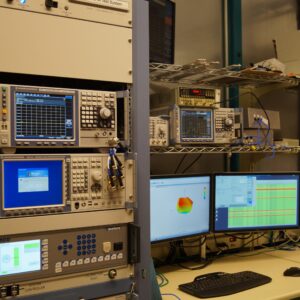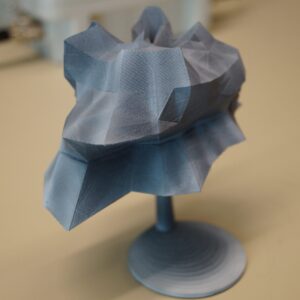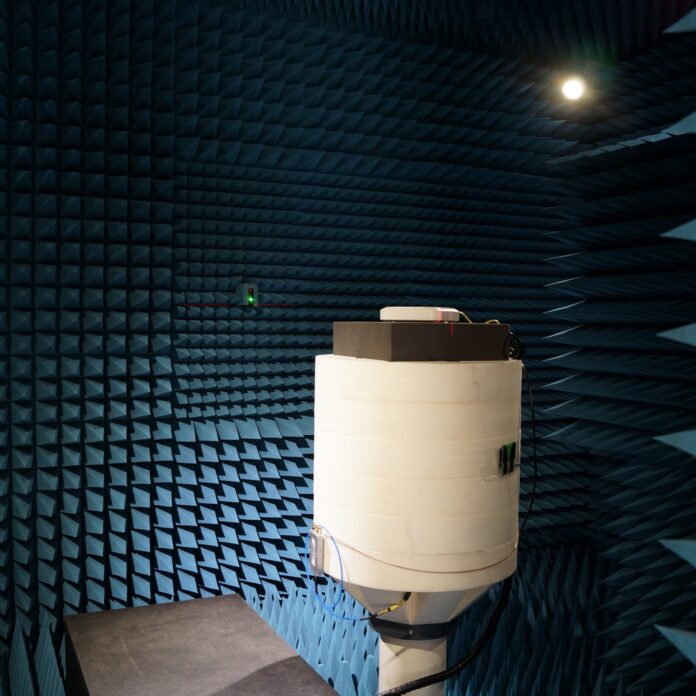LOUISVILLE, Colo. — The inside of CableLabs’ new anechoic chamber mimics the views outside, with the spiky blue pyramids calling to mind the Rocky Mountains that provide stellar views from the newly revamped facility.
Of course, your coverage is going to be nil compared to driving the nearby highway. Close the door to the thickly padded room, and coverage bars on a smartphone fall from four to zero in about 12 seconds.
CableLabs held a recent open house to showcase the upgraded facility, which has significantly expanded its test capabilities, particularly for Wi-Fi – hence the need for a cable research organization to have a special insulated chamber for radio frequency testing. The lab already has dozens of Wi-Fi devices that its members want tested, and according to Mark Poletti, lead wireless architect for CableLabs, the work will focus not only on specific devices’ performance but in improving Wi-Fi capabilities overall. For instance, he said, there is a federally required maximum power limit for Wi-Fi devices, but no minimum – and he points to a series of graphs on the wall that showcase wide variations in both power output and power sensitivity in Wi-Fi devices. CableLabs would like to establish a recommended minimum power output and sensitivity in order to improve Wi-Fi consistency and coverage overall.

The 16-foot by 12-foot by 12-foot, CTIA-compliant anechoic chamber is the centerpiece of CableLabs’ Wi-Fi testing capabilities, able to test devices operating between 700 MHz and 6 GHz. It just barely fits into its home, tucked back in the hallways of the otherwise spacious and airy workspaces.
In addition to the test results, CableLabs is also able to print fist-sized three-dimensional models that give physical form to the radio frequency propagation patterns of a Wi-Fi access point, illustrating where gain is best and worst. The information and the models may be able to help with installer training so that APs can be installed and positioned to give the best possible coverage.
Watch Poletti go over some of the additional RF test equipment for the chamber in the video below:
CableLabs engineers have also already dabbled in testing the use of LTE in unlicensed frequencies, which could impact Wi-Fi performance at 5 GHz.
Among the other research areas highlighted at the recent event:
• Testing in video quality. CableLabs looked at both objective video quality testing, which relies on computer algorithms, and subjective video quality testing. The latter involves bringing in real people to watch several hours of 10-second video clips: first an uncompressed reference sample, followed by the same sample that has been changed in some way, usually by various encoding or compression schemes. Watchers rate their perception of the video quality, with options that include sharing whether the difference is “barely perceptible” to how annoying they find the difference to be.
• 4K video, or ultra-high-definition. Some televisions – and a few mobile phones – already support 4K definition, and some content providers are starting to move small percentages of their content portfolios to availability in 4K. That trend is expected to continue, but there are a number of ways to approach a better picture and 4K is only one of them. Others include expanding the chromaticity range of televisions (so that more colors can be seen) or increasing the fineness of the contrast and the range of black/white – both of which require less bandwidth to implement than 4K. CableLabs provides test footage for the industry to use as well, shooting in 4K in order to have footage available for testing.
• Testing customers’ desire for and reaction to 365-degree video, or “immersive” video. The demo of the technology involved a video headset and headphones and showed a range of perspectives, including safari footage of wild animal close-ups, a football halftime show and city tours shown from a vantage point high above skyscrapers with the illusion of standing on air.

